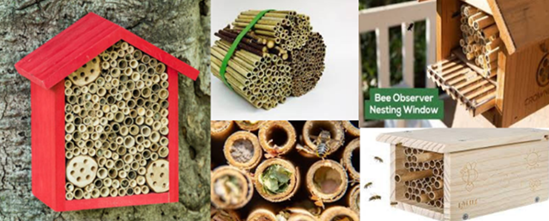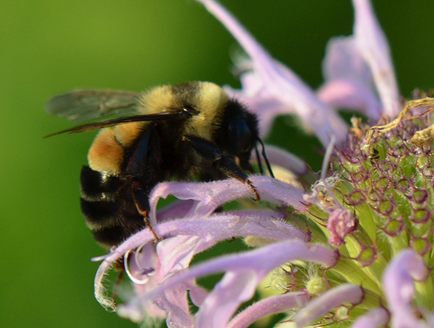|
by: Alireza Shokoohi, Robert Salerno and Leo Kerner Native pollinators are the largely unsung heroes of our ecosystems, but they face an alarming risk that we've long underestimated. New research from Dr. Vera Krischik’s lab shows that the situation may be more dire than expected. Dr. Krischik is an Associate Professor and Extension Specialist at the University of Minnesota investigating the impact of neonicotinoid insecticide residues on pollinators such as wild bees and butterflies. Her research is crucial for understanding and protecting the lives of these beneficial insects that we often take for granted. Neonicotinoids are a class of insecticides that were introduced about 30 years ago, and they are named so because their chemical structure resembles that of nicotine. They were introduced as an improvement on traditional insecticides due to their high toxicity towards insects, making them highly effective against many insect pests, and low toxicity towards vertebrates, making them safer for humans. Additionally, these insecticides are systemic, which means they get absorbed and carried to different tissues including shoots and leaves. Nowadays, they are used as insecticide seed treatments, meaning crop seeds are already coated with them before being planted, leading to fewer repeated treatments. However, neonicotinoids are also ubiquitously used in many consumer products and agricultural crops as soil and foliar treatments. The systemic properties of neonicotinoids have resulted in residues being found in the pollen and nectar of target and non-target plants. Thus, a diversity of pollinators, including bees and butterflies, can be exposed to neonicotinoids. We may also have been underestimating the toxicity of neonicotinoids on pollinators. Most toxicity bioassays are focused on acute effects of insecticides, i.e., the concentrations of the chemical that lead to the insect’s death within a short period of exposure. However, Dr. Krischik’s research broadens the scope of impact surrounding chronic toxicity (i.e., long-term exposure) of neonicotinoids, revealing that even low doses of neonicotinoids can have adverse effects on the behavior, development, and lifetime expectancy of bees and butterflies (Krischik 2015). For example, bees acutely exposed to 180 parts per billion (ppb) of neonicotinoids have high mortality but chronic exposure to much lower doses (10 ppb) can cause bees to lose navigation and foraging abilities (Krischik 2022). Many species of native pollinators have suffered population declines, which may in part be due to widespread neonicotinoid usage. The Rusty patched bumble bee, Bombus affinis, historically had distribution across the eastern United States, Upper Midwest, and southern Quebec and Ontario in Canada. However, as of 2016, its population and range had declined to include only 13 states and 1 Canadian province (USFWS 2016). A similar story is true for many other native species of bees as well as many butterflies. Due to these nontarget effects, neonicotinoids were banned in 2018 in the European Union (EU) and, in 2023, all exemptions were denied by the EU Court of Justice. Neonicotinoids are also highly persistent in the environment; they can remain in the soil for years and potentially harm beneficial soil invertebrates. For example, the half-lives of neonicotinoids in soils can exceed 1,000 days, making it easy for them to accumulate with repeated use (Bonmatin et al. 2015). The negative effects of neonicotinoids are not isolated to invertebrates, either. Birds can become unintended targets by consuming neonicotinoid-treated seeds and insects. In the Netherlands, populations of insectivorous birds were reduced in areas with higher surface-water concentrations of imidacloprid (Hallman et al. 2014). In France, many bird species sampled, including pigeons, doves, and partridges, had nervous disorders following imidacloprid exposure (Millot et al. 2016). Additionally, neonicotinoid residues have been found in robins, eagle-owls, white crowned sparrows, buzzards, great prairie chickens, sharp-tailed grouse, and turkey (Anderson et al. 2023, Roy et al. 2017). So, what can we do to help? Implementing integrated pest and pollinator management (IPPM) both on small- and large-scale agriculture, as well as around the household will aid in efforts to conserve organisms which provide important ecosystem services. One example Dr. Krischik provided for IPM within agriculture is the use of no-till practices to control a seedling pest of spring rapeseed. This practice was able to reduce the abundance of the pest by 74% while avoiding the need to introduce neonicotinoids into the system.  Fig 2. Examples of bee hotels created to provide certain native bees with nesting sites. Fig 2. Examples of bee hotels created to provide certain native bees with nesting sites. On a smaller scale, even if you can’t alter the practices of farming operations next door, there are plenty of actions you can take in your own backyard to support bees, birds, and butterflies! To support native pollinators, Dr. Krischik suggests building a bee hotel like the ones pictured above and outlined here. Native bees use the stems as homes for their young, but make sure you clean out the stems each year to prevent your guests from being afflicted with diseases and parasites. Planting native wildflowers in your backyard is another great way to provide food and nesting sites for bees, butterflies, and other pollinators. For more information, check out the University of Minnesota website where Dr. Krischik publishes plenty of fantastic resources for pollinator conservation. You can also support native songbirds and hummingbirds by setting up bird houses and feeding stations. Many of the birds you see in your backyard have specific housing and dietary requirements. Check out this link below to learn more about the requirements of common birds in the northeast United States. Remember, every effort counts! Authors: Alireza Shokoohi is a M.S. student in the Lamp Lab at the University of Maryland currently studying conservation biological control using ground beetles in agricultural drainage ditch ecosystems. Robert Salerno is a M.S. student in the Lamp Lab at the University of Maryland investigating subterranean arthropods and natural enemies of semi-natural habitats within agroecosystems. Leo Kerner is a M.S. student in the Hooks lab at the University of Maryland, studying the potential for living mulch cover crops as a sustainable alternative to chemical and high input management pest control. Sources: Anderson, M. J., Valdiviezo, A., Conway, M. H., Farrell, C., Andringa, R. K., Janik, A., Chiu, W. A., Rusyn, I., & Hamer, S. A. (2023). Imidacloprid exposure is detectable in over one third of wild bird samples from diverse Texas ecoregions. Science of The Total Environment, 876, 162723. https://doi.org/10.1016/j.scitotenv.2023.162723 Bonmatin JM, Giorio C, Girolami V, Goulson D, Kreutzweiser DP, Krupke C, Liess M, Long E, Marzaro M, Mitchell EA, Noome DA, Simon-Delso N, Tapparo A. Environmental fate and exposure; neonicotinoids and fipronil. Environ Sci Pollut Res Int. 2015 Jan;22(1):35-67. doi: 10.1007/s11356-014-3332-7. Epub 2014 Aug 7. PMID: 25096486; PMCID: PMC4284396. Hallmann, C. A., Foppen, R. P. B., van Turnhout, C. A. M., de Kroon, H., & Jongejans, E. (2014). Declines in insectivorous birds are associated with high neonicotinoid concentrations. Nature, 511(7509), 341–343. https://doi.org/10.1038/nature13531 Krischik, Vera. “Protecting Bees and Beneficial Insects from Systemic Insecticides Applied in Landscapes.” Protecting Bees and Beneficial Insects from Systemic Insecticides, University of Minnesota, 2022, ncipmhort.cfans.umn.edu/sites/ncipmhort.cfans.umn.edu/files/2022-06/Protecting_Bees_from_Systemic_Insecticides_2022.pdf. Krischik, V., Rogers, M., Gupta, G., & Varshney, A. (2015). Soil-applied imidacloprid translocates to ornamental flowers and reduces survival of adult Coleomegilla maculata, Harmonia axyridis, and Hippodamia convergens lady beetles, and larval Danaus plexippus and Vanessa cardui butterflies. PloS one, 10(3), e0119133. Millot, F., Decors, A., Mastain, O., Quintaine, T., Berny, P., Vey, D., Lasseur, R., & Bro, E. (2016b). Field evidence of bird poisonings by imidacloprid-treated seeds: A review of incidents reported by the French Sagir Network from 1995 to 2014. Environmental Science and Pollution Research, 24(6), 5469–5485. https://doi.org/10.1007/s11356-016-8272-y Roy, C., Chen,D., Ponder, J., Jankowski, M., Coy, P. (2017). Department of Natural Resources, Wildlife Restoration, and the Environment and Natural Resources Trust Fund. Neonicotinoids on the Landscape: Evaluating Avian Exposure to Treated Seeds in Agricultural Landscapes. U. S. Fish and Wildlife Service. (2016). Rusty Patched Bumble Bee (Bombus affinis) Species Status Assessment. https://ecos.fws.gov/ServCat/DownloadFile/120109 Zhang, C., Wang, X., Kaur, P., & Gan, J. (2023). A critical review on the accumulation of neonicotinoid insecticides in pollen and nectar: Influencing factors and implications for pollinator exposure. Science of The Total Environment, 165670. Comments are closed.
|
Categories
All
Archives
June 2024
|
Department of Entomology
University of Maryland
4112 Plant Sciences Building
College Park, MD 20742-4454
USA
Telephone: 301.405.3911
Fax: 301.314.9290
University of Maryland
4112 Plant Sciences Building
College Park, MD 20742-4454
USA
Telephone: 301.405.3911
Fax: 301.314.9290


 RSS Feed
RSS Feed




